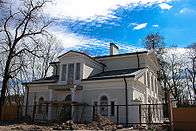Karol Podczaszyński
Karol Podczaszyński (Lithuanian: Karolis Podčašinskis) (7 November 1790 – 19 April 1860) was a Polish architect, a representative of the neoclassical architecture and a professor of the Imperial University of Vilna, as well as one of the pioneers of industrial design.



| Wikimedia Commons has media related to Karol Podczaszyński. |
He was born on 7 November 1790 in the village of Żyrmuny near Lida, in what is now the Hrodna Voblast of Belarus. He graduated from the prestigious Polish Liceum Krzemienieckie and the Imperial University of Vilna. Between 1814 and 1816 he continued his studies on architecture in St. Petersburg, where he became the first Pole on the Imperial Academy of Arts. Between 1817 and 1819 he also travelled to Western European countries, visiting Königsberg, Danzig, Berlin, Paris, Naples, Venice and Vienna before returning to Cracow. Upon his return to Vilnius he was offered a chair of architecture, which he accepted.
Among his most notable architectural works are the refurbishment of the interior of the Vilna University (1802-1804), including the Aula's interior, Evangelical Reformers' Church (1829-1835) and the neoclassical Jan Śniadecki's manor in Jašiūnai (reconstructed between 1824 and 1828). Yet another of his major works was the neo-Palladian Tusculanum manor (in modern Žirmūnai, Vilnius), completed in 1825. The entire Žirmūnai microdistrict in Vilnius was named after his native village, a part of the Polish-Lithuanian Commonwealth at the time of his birth.
As a noted architect, Podczaszyński also supervised a number of other projects, among them the reconstruction of the Palace of Governors in Vilnius, carried out by Vasily Stasov. In modern times the palace serves as the seat of the President of Lithuania. Podczaszyński has also reconstructed the Orthodox Cathedral of the Theotokos into the Anatomicum of his alma mater (1822). Finally, between 1836 and 1838 he designed the interior design of three chapels of the St. Władysław and Stanisław Cathedral of Vilna. In 1839, Karol Podczaszyński took the first known daguerreotype in present-day Lithuania.[1]
As a theoretician, Podczaszyński authored works on architecture and industrial design. Karol Podczaszyński died on 19 April 1860 in Vilnius and was interred in Rasos Cemetery.
Karol's son, Bolesław Podczaszyński also became a noted architect.
Publications
Among the best-known of his publications are monographs on industrial design:
- On the beauty of works of industry (Polish: O piękności w robotach przemysłu; 1821)
- Application of general principles of excellence of industrial designs in paintings, sculptures and garden design (Polish: Zastosowanie ogólnych zasad doskonałosci w tworach przemysłu do obrazów i posągów, tudzież do urządzenia ogrodów rozkosznych, czyli ogrojców; 1838)
He also prepared dictionary of Polish carpentry terms (Polish: Nomenklatura architektoniczna, czyli słowomiennik cieśliczych polskich wyrazów 1843). Karol Podczaszyński was also the author of two handbooks of architecture for universities: one for professors (1822) and one for the students (published in three volumes between 1828 and 1856).
Karol's son, Bolesław Podczaszyński also became a noted architect.
References
- (in Lithuanian) Several photographs of Vilnius' constructions of the 1860s